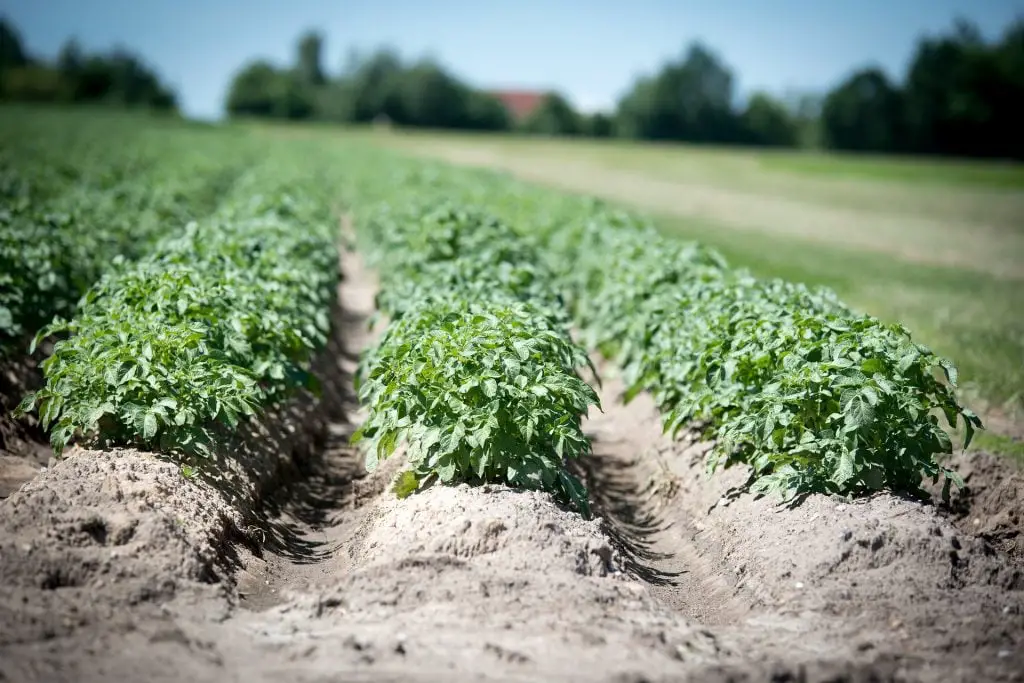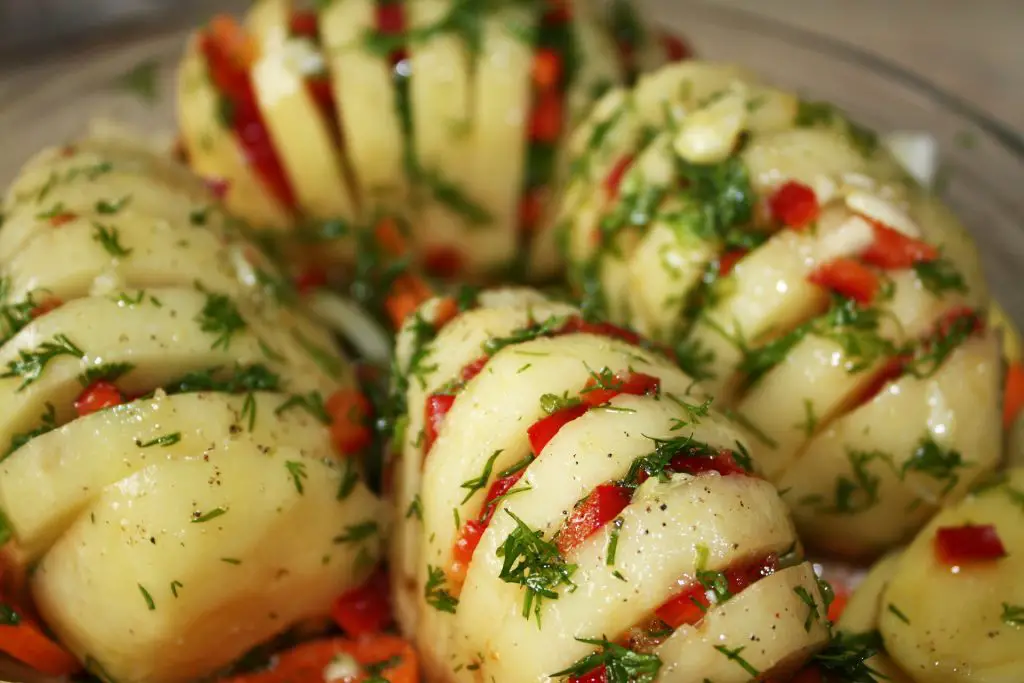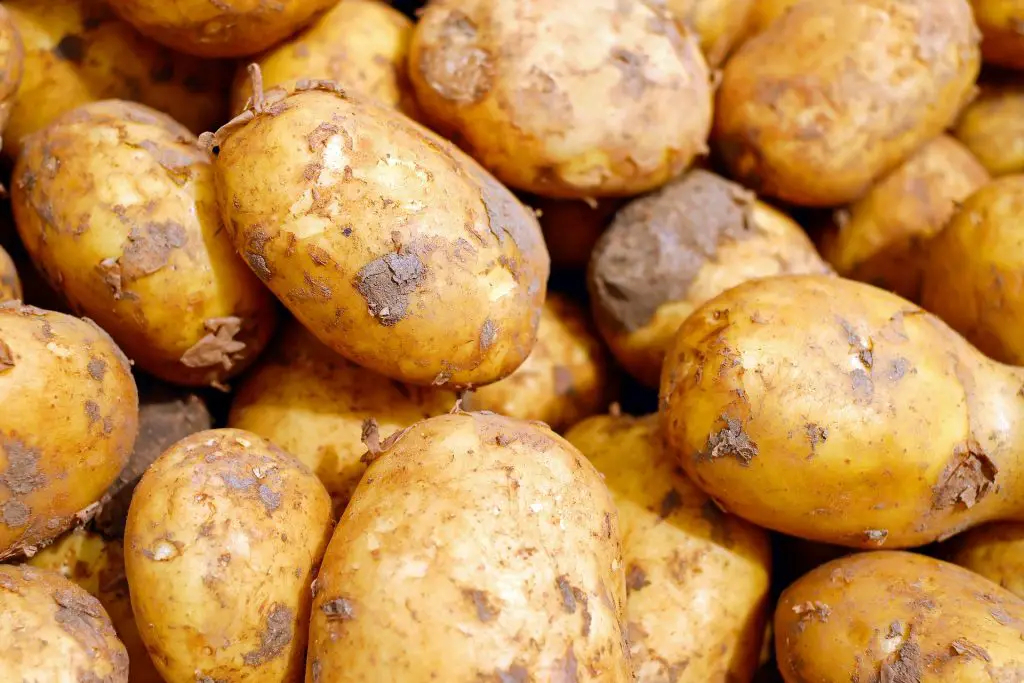How Much Does Each Seed Potato Produce? The potato has become a stable part of the diet in most parts of the world. This popularity of the potato can be attributed to how easy it is to grow and also its’ excellent yield. But when deciding how many seed potatoes to plant it is important understand what volume of potatoes will be produced for every seed potato planted.
For maincrop potatoes a yield of approximately 2kg (4.4 lb) per seed potatoes planted can be expected though it can vary at little with the variety. For first and secondly early potatoes grown in bags a yield of between 400 to 500g (1 lb) is quite common. However, the size of the yield for early potatoes is highly dependent upon the timing of the harvest. The longer they are left in the bag the greater the yield.
For the benefit of those that are unfamiliar with the different types of potatoes first early potatoes are earliest to potato crop to arrive. They take 10 to 12 weeks to mature and usually arrive around June. Second earlies take around 12 to 16 weeks to mature and usually are harvested in July.
Main crop potatoes take between 16 to 22 weeks to mature and are generally harvested in August or September. These are generally the largest potatoes and typically store the best. However, due to the size of the harvest the seed potatoes need to be spaced much further apart when planted, 75cm (2.5 ft) is common compared to 30cm (1 ft) apart for first earlies.

Does the Size Of The Seed Potato Matter?
When purchasing a bag of seed potatoes the size of the potatoes often varies quite a bit. So does this really matter?
Most seasoned gardeners have had the experience of planting potatoes in one year and harvesting them only to find potato plants popping up in the same place the following year because a couple of tubers the size of a pea or an egg have been missed.
This experience tells you that even quite small potatoes, if left in the soil, will sprout. However, the size of the tubers is often really small which further indicates that there is a minimum size of potato that you want to plant. Additionally, a study conducted in our trial garden also suggests that there is some a correlation between the size of the seed and the yield.
Based on this data, which is limited, I would suggest that the minimum size you would want to plant seed potatoes at is 30 to 40 grams (1 to 1.4 oz). To read more about this study click here.
To get the most out of your seed potatoes you may also consider cutting them in half. This will allow you to plant more individual seed potatoes that will produce a larger crop provided you have the room in your garden. The only down side of cutting seed potatoes in half is there is a greater risk of the tuber rotting in the ground.

However, my experience has been that this very rarely happens and the benefit of an increase in the harvest far outweighs the risk of failure of one or two of the seed potatoes.
How To Grow Potatoes
Potatoes are one of the easiest vegetables to grow in the garden and the potatoes will reward you will an enormous harvest.
To plant Potatoes in the garden start by digging a 30 cm (1 ft) deep trench. Place the seed potatoes at the bottom of the trench about 50 to 60 cm (2 ft) apart for main crop potatoes and 30cm (1 ft) apart for early potatoes. Cover the potatoes over with soil by partial refilling the trench. Planting is best done around 4 weeks prior to the last frost which for most places is in early spring.
A range of seed potatoes is available from Seeds Now in the US alternatively they can be purchased from Thompson & Morgan or yougarden.com in the UK or from here.
Once the Potatoes are planted it will take a few weeks for shoots to appear. As the shoots appear earth should be mounded up around the Potato plants. This will encourage the development of additional tubers. The other important role mounding plays is it excludes light from the developing tubers. This is important because light will cause the tuber to go green and become poisonous.

About 4 weeks after when the plant begins to flower you can to begin harvest to the Potatoes. When harvesting the potatoes it is best to use a fork or harvest by hand as using a spade will result in tubers being cut in half.
Potatoes can be harvest as needed from the garden until all the top growth completely dies back. At this point it is necessary to dig up the remaining potatoes.
Main Crop Potatoes can be stored for an extended period of time if they are stored in a cool dark place that is ventilated. Storing the a hessian sack is ideal, which can be purchased from What Are The Best Early Potatoes to Grow?
The results quoted were based on a harvest of potatoes after 10 weeks in a grow bag. Prior to planting each variety was chitted for 7 weeks, before being planted in early April. The result for those Potato varieties that received an Award of Garden Merit are shown in the Table below. For full details of the trial click here.
| Variety | Yield Per Seed Potato (g) | Average Tuber Weight (g) |
| Lady Christl | 508 | 36 |
| Sharpes Express | 490 | 37 |
| Vales Emerald | 470 | 37 |
| Casablanca | 468 | 44 |
| Jazzy | 450 | 25 |
| Maris Bard | 430 | 41 |
| Golden Nugget | 420 | 26 |
| Charlotte | 380 | 40 |
What Are The Best Main Season Potatoes to Grow?
A similar trial on main crop potatoes was carried out by the RHS in 1993. In this trial 26 varieties of potatoes were evaluated on the basis of Yield, Skin and the size of the tuber. Of these potatoes 7 varieties were given the Award of Garden Merit. These varieties were;
- Avalanche
- Croft
- Famosa
- Picasso
- Stroma
- Navan
- Maxine
The full results of the trial that was published are shown in the table below. The yield from most varieties was relatively consistent with the majority of varieties producing between 1.7 and 2.7 kg per seed potato planted.
From this it is apparent that irrespective of the variety you chose to grow you can expect to a reasonable harvest.
| Variety | Yield | % Small | % Medium | % Large |
| Charisma | 3.2 kg (7.0 lb) | 2 | 21 | 77 |
| Picasso | 2.7 kg (6.0 lb) | 3 | 44 | 53 |
| Stemster | 2.7 kg (6.0 lb) | 3 | 40 | 57 |
| Valer | 2.7 kg (6.0 lb) | 4 | 54 | 41 |
| Avalanche | 2.6 kg (5.8 lb) | 4 | 68 | 28 |
| Croft | 2.4 kg (5.4 lb) | 6 | 79 | 15 |
| Navan | 2.4 kg (5.4 lb) | 4 | 42 | 55 |
| Heather | 2.4 kg (5.4 lb) | 2 | 57 | 40 |
| Crispin | 2.4 kg (5.4 lb) | 2 | 50 | 48 |
| Nadine | 2.4 kg (5.4 lb) | 19 | 72 | 9 |
| Sante | 2.3 kg (5.1 lb) | 12 | 54 | 34 |
| Maris Piper | 2.2 kg (4.9 lb) | 5 | 74 | 21 |
| Desiree | 2.2 kg (4.9 lb) | 5 | 60 | 36 |
| Stroma | 2.2 kg (4.9 lb) | 4 | 89 | 8 |
| Penta | 2.2 kg (4.9 lb) | 5 | 64 | 31 |
| Fianna | 2.2 kg (4.9 lb) | 10 | 63 | 27 |
| Maxine | 2.1 kg (4.7 lb) | 7 | 91 | 2 |
| Portland Dell | 2.1 kg (4.7 lb) | 6 | 83 | 11 |
| Obelix | 2.0 kg (4.5 lb) | 5 | 69 | 26 |
| Cara | 1.9 kg (4.2 lb) | 11 | 60 | 29 |
| Kirsty | 1.9 kg (4.2 lb) | 2 | 73 | 25 |
| Stamina | 1.8 kg (4.0 lb) | 16 | 63 | 21 |
| Famosa | 1.8 kg (4.0 lb) | 9 | 67 | 24 |
| Ailsa | 1.7 kg (3.8 lb) | 13 | 80 | 7 |
| Kestral | 1.7 kg (3.8 lb) | 7 | 80 | 14 |
Related Articles
Can You Cut Seed Potatoes in Half?
Can I Plant Store Bought Potatoes?
What Are The Best Potatoes To Grow In Bags?
Can You Plant Old Potatoes That Have Sprouted?
Does Earthing Up Potatoes Improve Yield? Is It Worth Doing?
How Much Sun Do Potatoes Need? Does The Yield Fall In Shade?
Are Potatoes A Root Vegetable?
How Late Can You Plant Potatoes? (And How To Maximize The Yield)
Can You Compost Potatoes? Or Will They Start Growing?
